What do you do when your Facebook ads campaigns don’t perform? Let us guess. You check the Cost per Conversion (CPA) or Cost per Click. And you think you’re done.
What do you do if you still don’t get the results you want? You go back to the dashboard and look again at the… CPC or CPA. Then you think you’re cursed, or someone is boycotting you.
What if we told you that there is a silent but deadly enemy right there, hidden in plain sight in your analytics? It’s your Facebook ads Frequency.
Facebook ads frequency is often overlooked but, as our data clearly shows, it could very well be the reason why your campaigns are starting to underperform.
If you think Facebook’s native frequency algorithm is more than enough to give you peace of mind, we’ll show you that sometimes it’s simply not enough.
And those are exactly the times when Facebook ads frequency is damaging your advertising efforts.
With these 3 strategies in place, you can rest easy knowing that your frequency will never be too high, and your audience will see a refreshing blend of ads in their newsfeed.
Let’s step back to you monitoring the CPA or CPC of your Facebook ads.
We don’t blame you; those are the metrics we check first every day and the ones we care a lot about.
But…
CPC, CPA & Beyond
Here’s the problem:
CPA and CPC only tell you HOW your campaign is doing but nothing about WHY it is doing well (or poorly).
Thus, when it comes to optimizing your campaigns CPA and CPC are not enough.
Of course, you can abolish all ads that cost a lot. That works, but not in the long term.
Sooner or later, in fact, you’ll end up having to pause all your ads and start from scratch, with no clue about what happened to the previous ones and no information to guide you with the new campaign.
To really understand why your ads are not performing as well as you want you’ll need to analyze more metrics.
Just to name a few: the Click-Through rate, the Conversion rate, and the Frequency.
The latter is probably the most ignored of the three. And we’re here to fix it!
While we like to think of the word frequent as being something positive, with Facebook ads that word does not have the same connotation.
As customers ourselves, most of us have experienced the same issue when we’ve visited a website and then been shown the same ad for 90 or even 180 consecutive days.
Even worse, after you’ve purchased something from the website, you’re still retargeted with an ad to buy that same product.
Annoying, right? In our case, it’s both annoying for the customer and expensive for the business.
In this guide, we’ll not only break down the true meaning of Facebook ads Frequency, but we’ll also show you (with numbers) how its silent but deadly effect is damaging your Facebook ads campaigns.
Not enough? We will also give you 3 exclusive proven strategies you can use in 2018 to combat Facebook ads frequency and decrease Facebook ad fatigue.
Ready? Here we go!
What is Facebook Ads Frequency, Anyway?
Frequency, as defined by Facebook, is the average number of times your ad was served to each person.
As your campaign spends more money and serves more impressions your frequency will increase – that’s just basic math.
Let’s do the math:
Impressions:# of times your ads were displayed
Reach: # of unique users your ads reached
Frequency: # of times your ad was served to each person (average)
Frequency = Impressions/Reach
Here’s an example:
This campaign’s ads were viewed 16,190 times by 12,586 unique users. 16,190/12,586 = 1.29
Of course, Ad Frequency is not an exact metric and that’s why Facebook talks about an “average number”.
For example, there’s no guarantee that everyone reached by your ads has seen them exactly 2 times. One user could have seen your ad 3 times and another just once.
Luckily, you don’t need to be this exact. Once the numbers are large enough, these variations are irrelevant.
Ok, so that’s the theory, but why does this matter at all for your campaigns’ optimization?
Why Facebook Ads Frequency Matters
For two reasons, one is very scientific, the other strictly practical:
1) Banner Blindness
We explained a lot about Banner blindness and how to stop Facebook Ad CTR decline, and we shamelessly showed you that it played a big role in not one but two of the Six worst errors we’ve made with Facebook Advertising.
Massimo Chieruzzi, an entrepreneur, inbound marketer, geek, blogger, journalist, and Facebook Ads Top expert that also happen to be the creator of AdEspresso (together with Armando Biondi and Carlo Forgheri), states:
In my opinion, Banner blindness is one of the key concepts you need to understand when advertising.
Not just on Facebook, everywhere.
The average Internet user is exposed to 1,707 banners each month according to Comscore. That’s a lot of advertising!
And what’s worse is that after a while the brain develops a sort of self-defense mechanism: it completely filters out banners from the content it’s viewing.
The scientific data is confirmed by Infolinks study (and great infographic), which revealed that only 2.8% of participants thought that ads on websites are relevant.
As soon as the brain starts to understand that there are banners in a specific position of a website or identifies a design as a banner, it filters it out, as if it never saw it. Ouch! That’s clearly bad for our Click-Through rate.
As your frequency goes up, your audience is being more and more exposed to your design and Banner Blindness will kick in reducing the effectiveness of your campaign, lowering your Click-Through rate, and increasing your CPC and CPA.
2) You’ll Just Irritate Users
The second reason you should care about Frequency is less scientific and far more practical.
Think about it. Once you’ve seen an ad 5, 6, 10 times, either you’re interested in it and you’ve clicked on it, or you don’t care about the product advertised and you’ll get really annoyed by seeing the ad every single day in your Facebook timeline.
The result is, of course, a decrease in performance that can quickly transform into a dislike of your brand.
Analyzing many campaigns, we saw that as the frequency went up, angry comments started to appear in the ads with angry users asking that they stop, if not outright insulting the advertiser.You don’t want to get to this point!
Let’s Analyze Some Data!
If you follow this blog, you know that we like data! The internet is full of dull articles on Social Media topics, mostly written by self-proclaimed Social Media Gurus who often have never created a campaign in their lives.
When we write about something we provide you with valuable insights that are data-driven and, given the fact that thousands of marketers around the world manage almost 300 million dollars of ad spend every month in Facebook Advertising through AdEspresso, we’re in the perfect position to do it!
We analyzed a sample of 500 campaigns to look for a correlation between the campaign’s performance and the frequency.
The results are stunning.
As you can see, the more the frequency increased, the more the CTR decreased and the average Cost Per Click increased.
| Frequency | CTR Decrease | CPC Increase |
|---|---|---|
| 1 | 0 | 0 |
| 2 | -8.91% | +49.82% |
| 3 | -16.92% | +62.20% |
| 4 | -23.34% | +68.02% |
| 5 | -29.72% | +98.51% |
| 6 | -41.19% | +127.32% |
| 7 | -41.38% | +127.26% |
| 8 | -48.97% | +138.31% |
| 9 | -49.87% | +161.15% |
Numbers don’t lie, at a frequency of 9 the average cost per click increase by 161% compared to the beginning of the campaign.
Therefore, you need to constantly monitor your campaigns to understand how the frequency is impacting them!
This then begs the question that I get asked every day:
What’s the maximum frequency you should have?”
There’s no one-size-fits-all answer. It really depends on your industry and your margins.
At AdEspresso we start making changes to our campaigns when the frequency is near 5.
There are some industries, however, where the margins are very good and it could make sense to reach a higher frequency first.
We’d say you should try never to go above 10 in any case.
How Do You Fight Facebook Ads Frequency?
Given that no matter what you do, as your campaigns keep spending money your frequency will increase, there are a few tactics that will come in handy.
-
Find the right balance between your budget and your campaign’s audience size
If you have a $10 daily budget, even with a small audience size it’ll take time before the frequency becomes a problem. If you have a budget of thousands of dollars per day you’ll need to target a much bigger audience: hundreds of thousands of people.
-
React quickly
When the frequency of your campaign gets above 5, start monitoring it closely. If the performance becomes too low you have two options: refresh the design of your ads, maybe trying a different value proposition to fight banner blindness. Or stop the campaign and target a totally different audience. In a month, you can try targeting the original audience again and the results should be better. If you’re using AdEspresso we’ll inform you any time you need to take actions!
-
Exclude people that have already converted as a result of your targeting
There’s one thing that’s worse than displaying ads to someone who’s not interested: displaying ads to someone after he has already bought your product.
You won’t just upset a user, you’ll piss off a customer! Using Custom Audiences excludes existing customers from your targeting (unless you want to upsell something new!).
Isn’t Facebook’s Frequency Cap Enough?
A little-known fact is that Facebook does have their own built-in frequency cap to help address this issue.
You can find a mention of this in their support documents.
While this built-in cap is a great start, our campaign still can reach a high frequency very quickly, especially with smaller audiences.
Let’s put it in a real-life context.
Let’s say we have 2 rooms – Room A with 10 people and Room B with 1,000. If we randomly select a group of 3 from each room every six hours, we can be sure that we will reach everyone in Room A, with the same names being chosen over and over again. Even though we’re only drawing names every 6 hours, it doesn’t prevent the same person from being selected again and again.
Room B, on the other hand, would be a different story. Sure, we may have some names repeated, but we have a much higher pool of people who would have never been picked before.
This situation is exactly the one we’refacing with our audience size, and our ads being served to that audience. With this in mind, we know that need to take drastic action.
If you want to ensure you’re keeping your frequency down, then you need to implement these 3 strategies right now.
How To Fight Facebook Ads Frequency in 2018 Strategy #1:
Use Evergreen Retargeting Techniques
A common frequency issue arises with retargeting campaigns – it’s very common to see advertisers put all their warm audiences into the same campaign with the same ads over and over.
Thankfully, we can use an evergreen retargeting technique to prevent this problem. If you’re not familiar with the term “evergreen”, it means something fresh and new for the audience’s eyes – which is our goal here.
The main benefit of this setup is that the audience will dynamically update and move through a sequence of different campaigns, ensuring they will see new ads over time.
Not only that, but you can even leave this sequence on for months or even years, with some tiny maintenance touches from time to time.
Here’s how to do it in just 2 steps!
Step 1 – Create Your Audience
The first thing we need to do is to set up our audience into those segments that were just mentioned. There are several ways to do this depending on if you’re working with lead generation or eCommerce goals, but the example I will show you is with people who have visited your website within a specific time frame.
To start, we need to create 3 custom audiences.
- 1-4 day website visitors
- 1-8 day website visitors
- 1-12 day website visitors
Not sure how to create these audiences? You can refer to our guide here.
Step 2 – Create Your Campaigns
The next step is to set up our 3 campaigns that will house our ads for these audiences.
In each campaign, you will be excluding the other audience segments from the targeting.
Now, our ultimate goal here is to ensure people see different ads but don’t make the mistake of pitching the exact same offer in each campaign.
Try spicing up your sequence with different value-based offers like free shipping, coupons/discounts, or even a free item with a purchase or subscription.
With this setup, we can ensure that as the time that has passed since our users have visited our website increases, they will move into a new campaign and see new ads as a result.
If you want a step-by-step guide on how to create this sequence as well as some real-life case studies, you can check out our webinar below.
(NOTE: AdEspresso customers have access to join all of our monthly webinars live, and view the recordings on demand through the AdEspresso University – for only $19/month!)
How To Fight Facebook Ads Frequency Strategy #2:
Automatic Post Promotion to the Rescue
Are you relying on boosting the same old posts instead of swapping them around to keep things fresh? Perhaps you don’t have the time to keep rotating your ads if the frequency gets too high?
This can be solved with a “set it and forget it” Automatic Post Promotion campaign.
With Automatic Post Promotion, we can set a campaign that will boost posts to hyper-specific audiences by utilizing post link, social proof, or even #hashtags.
To get started, log into AdEspresso and from the What Do You Want to Promote section, select Page/Place Post.
On the next step, we can choose from 2 different ways to boost posts – but what we want for this example is the ‘automatically promote latest posts’ option.
Now, you can determine exactly what criteria you want to use to trigger the post to be promoted to the audience you specify on the next step.
There are several ideas you can use for this, such as:
- Boosting only the top performing content (using likes/comments/shares)
- Boosting specific content to unique audiences (using hashtags)
- Boosting content from your blog in a specific language to people who speak the same language (using link text indicators)
If you’re looking for a guide to All Things Boosted, check out our latest post which includes detailed setup instructions and 3 boosting strategies that can be applied to any business model.
How To Fight Facebook Ads Frequency Strategy #3:
Use Custom Rules
The last strategy is to fight frequency head-on with optimization rules.
Facebook does us a favor by including the natural frequency cap in the algorithm but we can take it one step farther and stop any ads from going over our favored frequency limit.
To do this, we’ll use the Optimization Rules located in AdEspresso.
The first step is deciding what your ideal frequency is.
We recommend that once an ad has a frequency six or higher, chances are you’re starting to hit ad fatigue and it’s best to take some action. Our rule will be to pause any ad with a frequency of over six.
To start, head over to the Tools tab and choose Optimization Rules at the top of the menu.
Now we can create our rules!
We’re going to limit the frequency of the ad itself, so we can set a rule that says if an ad has a frequency greater than 5, we’ll pause it.
The setup will look like this:
That’s it! Now once our frequency hits 6 or higher, it will be paused.
I’ve set this rule to check every day for ads that meet the frequency criteria, but you can just as easily change that if needed.
Aside from fighting frequency, there are a ton of other ways to use these rules – we can increase the budget of ads that perform well, decrease the budget of those that don’t, and even pause or start other campaigns!
If you’re looking for more advanced rules, you can read our guide to automation rules here.
One Last Piece of Friendly Advice
If you’ve followed us until this point, we’re confident that you will never neglect to monitor your Facebook ads frequency again! Kudos to you!
But, remember, Ad Frequency is not solely responsible for all the performance issues your Facebook ads might be having.
If you want to bulletproof all your next advertising campaigns and learn to track down and isolate any other enemy that might put at stake your advertising efforts, check out the 2018 update of our Simple Guide to Understand Facebook Ads Metrics and download The Evergreen Guide To Facebook Ad Optimization.
Want to take your digital advertising to the next level?
Sign up for our newsletter to be immediately be notified when the next post comes out!
Is there any other Facebook or Instagram or Google Ads issue we can help you with?
Get Our Expert Advice! Let us help you achieve the results your business deserves
Have more questions? Do you want to share your experience with Facebook ads Frequency and how do you deal with it? Or just thank us for the golden info in this post? Use the comments below 😉


 In my opinion, Banner blindness is one of the key concepts you need to understand when advertising.
In my opinion, Banner blindness is one of the key concepts you need to understand when advertising.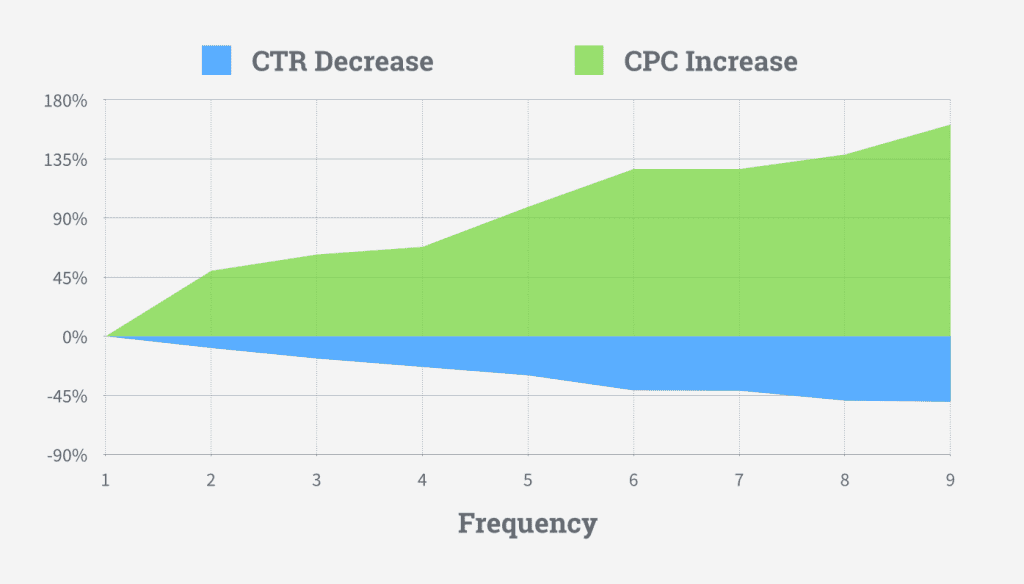

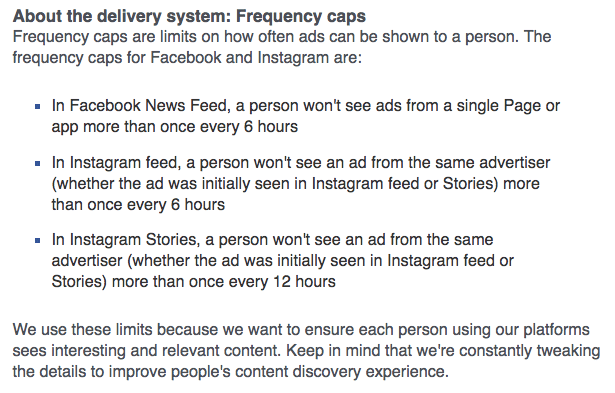


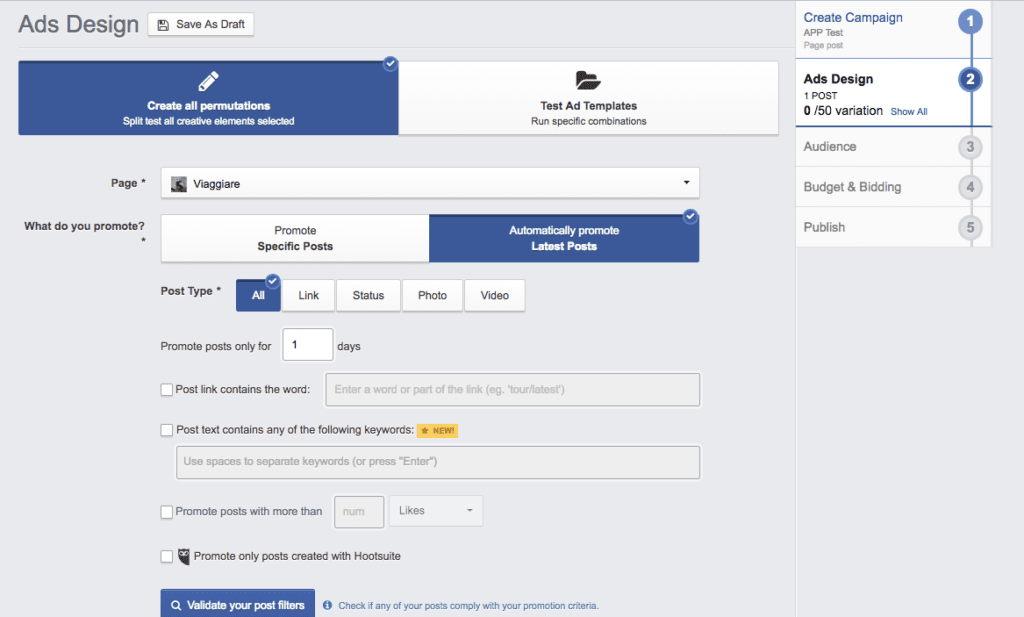
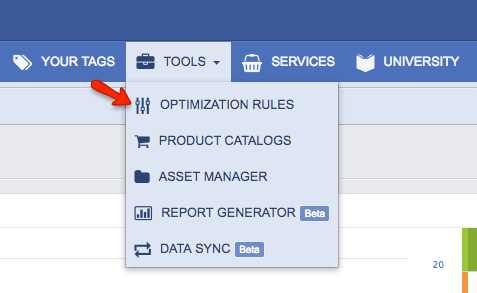
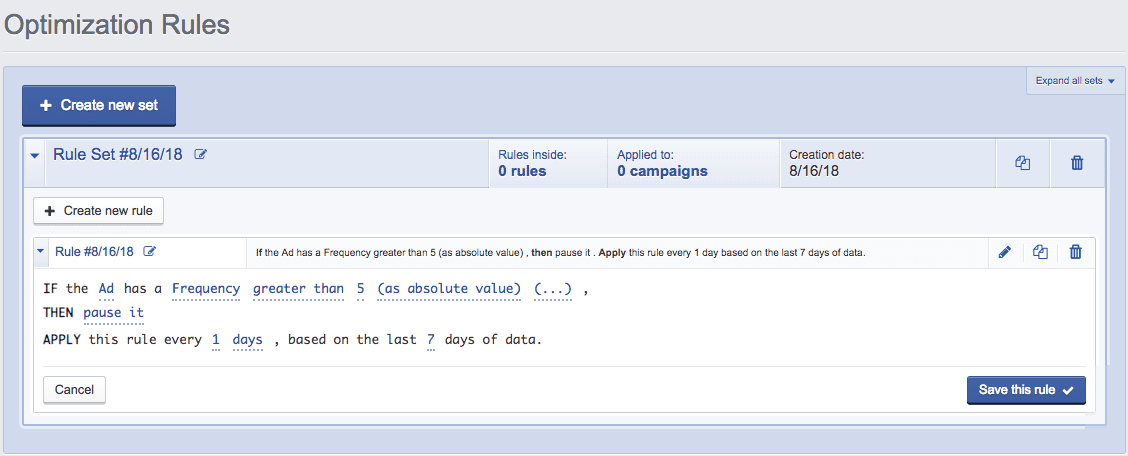
Wow, this is eye-opening, I had never checked the frequency of my campaigns, always considered it a secondary metric.
Thank you for all the data, I’ll start reviewing all my campaigns immediately and refresh those that have a very high frequency!
Thanks Pedro, glad the post was use useful! We’re looking forward to publish more data-driven posts. What topics would you like us to cover?
Thanks Massimo for this eye opener post!
Same here, I never checked Frequency 🙁
Never thought that due to high frequency my CPC is getting higher. Infact, I never glance my way to it.
Now after reading this post, added Frequency as a metric to see for ads.
Glad to hear it was useful Hyderali, we’re soon gonna publish more articles like this analyzing other important metrics, stay tuned!
Ciao Massimo, ho una campagna che è andata molto bene nell’ultimo mese ma adesso sta raggiungendo una frequenza vicina al 6 e non sta generando conversioni. Come devo comportarmi? Thanks!
“Self-proclaimed Social Media Gurus who often have never created a campaign in their lives”. This made me spit out my tea i chuckled so hard. So true, it’s clear you guys know what you’re talking about so from now on this is my go to for keeping up to speed with Facebook Ad’s!
Lol, thanks Andrew! There are a lot of great blogger on Facebook Ads like Jon Loomer and Jason How but most of the blogs out there are just crap!
On our side, we always try to provide numbers to prove what we write. I think that’s the best way to really add value 🙂
That’s a great policy, from a newcomers perspective interpreting data can be tricky so seeing concrete examples broken down is very valuable. Kudos guys!
Great article.
I would like to read a article about using Custom Audiences to exclude existing customers from my targeting.
So I don’t show the ads after he has converted.
Thank you for this great post.
Here are a few insights i could come up with from reading your post :
1/ CPC increase and CTR decrease should be propotionals if the bid of frequency n = bid of frequency n+1 =… = bid of frequency 9
->Therefore Facebook ( or adespresso algorithm ) probably bid on much more wanted impressions as the frequency goes up, probably in order to keep the CTR high.
That would be interesting to have your feedback here.
2/ CTR decrease is ( on regular display advertising ) way more important than that : CTR of frequency 2 will be 50% less than CTR of frequency 1 ( on average ). Maybe what i mention in 1/ can explain the diference that i describe in 2/
3/ On regular display advertising, CTR would plateau after the 8th frequency. This seem to be the case as well in your graph.
Would love to have your feedback,
Best,
Nicholas.
Hey Nicholas thanks for the amazing comment.
There may be different explanations for the increase in CPC. One is likely that, as you mentioned, as Facebook tries to reach a different audience to keep the Frequency low, it has to increase the bid to display the ads to more expensive users.
This is really tough to study, we’d need to check what % of the potential reach was reached at each frequency point. The behavior is probably different if audience is totally reached Vs there’s still untapped audience to reach.
I agree on the plateau at 8. Honestly our latest data show that, if there’s still space to reach new users, Facebook lately is trying to cap the Frequency at 5 as much as it can.
What timeframe are you using for these frequency metrics? Daily, weekly, monthly, entire life of an ad? You mentioned pausing an ad and then running it again a month later to avoid banner blindness so I assume it’s not lifetime.
For example, In TV advertising, we are exposed to the same ad over and over and over… maybe even 3+ times per hour and definitely more than 3x per day on a channel. Granted web ads are different, but it seems like total lifetime frequency for a TV ad is probably in the hundreds. If we compare TV ads to “video view” ads on Facebook (instead of comparing to “website clicks” campaigns) does the frequency change?
Last question. It seems like refreshing the same ad with a different image would be more effective than just changing out the text but leaving the image alone.
Thoughts?
Cheers
I’d like to know this too. My guess is daily, but it isn’t made clear here.
Damn! I wasn’t even looking at frequency until I read this post! Thanks a ton. My mobile ad targeting the female audience has an 8-12% CTR, while similar ads (same picture diff words) targeting desktop (male and female) had a 0.05% CTR. I noticed the frequency on the first ad was 1.0 while that on the latter ads was upto 1.8. However my audience size (based on interests) is well into millions of users. Then why is it that Facebook keeps targeting the same people on the desktop ads?
And why is my CTR is so ridiculously different for 2 very similar ads on different platforms?
PS: I’ve been using CPC for the better performing mobile ad and just switched to oCPM for the non-performing desktop ads.
Hey Zubin, what’s the objective of your campaigns? For some objectives like engagement mobile works extremely well. Keep in mind that right now mobile traffic is likely 70% of Facebook’s overall traffic so the audience over there is much bigger.
On desktop are you using Right column or newsfeed? 0.05% seems a CTR of the right column, such a big difference between mobile vs desktop newsfeed is really huge.
Also are you testing them in 2 different adsets? That may help allocating a specific budget to each experiment and getting more reliable data.
Ciao,
Max
Yes, I was using two different adsets. I have discontinued the desktop ads altogether.
The objective is to drive traffic to my website (and hopefully convert to more sign-ups) which provides online medical consult with doctors.
With a 7-12% CTR; 0.21 USD/ click (target US, UK and Canada ONLY), do you think my CPC ads for mobile are doing well or will I get even better results with oCPM?
Thanks a ton for the fantastic posts! It’s the best advice I have seen on the topic. Hoping to start the adespresso free trial soon!
Hey, your stats is impressive. I run ads for the similar target but my CTR is really low. Can you share some insights abt your product and your ads. TIA
Thanks Liz! Best way to see tool + get advices is to join my weekly webinar. It’s every Wed. at 10am PT, you can signup here.
We do almost exclusively video ads and frequency is a huge portion of our metrics. However even on ads that have been served 20,000+ our frequency remains 1.8-2.5 . What is the suggestion to increase frequency. We care a little about click-throughs and more about impressions. Our demographic is tight but always above 50k.
Very useful information, keep on doing that great work!
Yes great post.
I use conversion optimizer and my campaign rarely go above a frequency of 2. I guess that’s because Facebook realizes that it can’t sell me those eyeballs at the max bid I set once the frequency gets too high.
Still, it’s great to have this data.
Yes, when you use oCPM, lately Facebook has started managing the frequency in a pretty good way. Even with big spending they usually keep it below 4. If you go with CPC or CPM it’s a bit more risky.
Thanks for the great post, Massimo. I am currently having my first wild experience with frequency in a Page Like campaign. My client is a small liberal arts college whose goal is to get as many alumni connected to their page (likely for the purposes of fundraising + building awareness). The issue I’m running up against is that their target audience is very small and therefore, we reached everyone pretty quickly. I created a custom audience using their email list (about 13.5k) and Facebook matched to about 8,000 user records. I then excluded a subset of those users who were already connected to the page (about 2,700). That whittled my possible reach down to 5,300 users. With that, we launched the campaign and were off to the races. The CPA was incredibly low the first few days ($0.19), but now I’m realizing those users were the low hanging fruit– perhaps alumni that are fond of the college and didn’t realize they were not already connected to the page. However, the CPA pretty quickly began to skyrocket. Just 2 weeks in, CPA is hovering around $1.07, but alarmingly, frequency is around 10! At this point, I think banner blindness has occurred and/or users who have no desire to be connected to the page are getting annoyed and will never click Like.
As of last week, Facebook rolled out new options for Page Like ads, including a video slide show. I’m wondering if trying something a bit more dazzling like that would have an impact on the more expensive/resistant users, or if I should just pause the campaign altogether.
This is my first time running a campaign to such a tiny audience– and one that is very specific. I can’t create look alike audiences or try to reach friends of fans because the users have to be alumni. It’s very tricky! I’d love to hear your thoughts!
Maura,
You’re thinking right, you obtained the low hanging fruit and it’s time to optimize by testing new factors (image, ad type, etc. I recommend copy at first- try different angles such as offer a benefit (“Like us to stay up to date with X university.”, “Did you know alumni can use resources free? Like us to learn more!” etc…)
Where can I find my add frequency stats?
Hey Massimo,
Great post! Love how you included concrete data to really get the concept through.
I actually have the same question as Zubin above – my potential audience is quite large (300,000) compared to my current reach (50,000), but my frequency is higher than I would think reasonable (1.5), and I even have a few comments saying they see the ad in their newsfeed every day! (Obviously on the extreme end of the range, but still a bit annoying…) Would you know why this is, and how to limit frequency manually?
PERFECT!
Hi-
Great article!
Quick question, the frequency changes based on your time horizon. The longer time horizons tend to have frequencies that climb a little higher. Is your analysis based on frequency within a single day? 3 day rolling period?
My issue is that on a single day the frequency sits at 1.3-1.4. But on a week long rolling period it sits at about 3. vastly different numbers that dictate different decisions going forward.
any help would be great!
Hey Matt, the post is lifetime frequency. So from the day the campaign was created 🙂
I think a frequency of 3 on a weekly basis is overall pretty good!
why does the CPC change at such rapid % levels while CTR doesn’t ?
hi, this is great article. thanks for your awesome insights 🙂
anyway after read this article and also this >> https://adespresso.com/academy/blog/facebook-ads-relevance-score/
i feel great, because my relevance score = 9 and frequency = 1 (my campaign is now running on second day)
i sale fashion item like bags, shoes and many more, but still no sales.
i do split test on my items, and now i figure it out what item that have good engagement(i’m using PPE).
next i plan to split test the age, am i right? or i have to split test the other ?
waiting for your great insights 🙂
Regards,
Muh Djayusman Riyadhi
I’m a little confused. When the frequency gets too high are we supposed to just “edit” the ad or we will need to create a whole new campaign or adset??
It doesn’t really matter, either ways are fine!
Where is this ads frequency mentioned in Ads Manager? I’m not able to find it.
It’s surprising to find on adespresso.com a resource so
precious about equations.
We will note your page as a benchmark for Silent but deadly:
the Frequency of your FaceBook Ads.
We also invite you to link and other web resources for equations
like http://equation-solver.org/ or https://en.wikipedia.org/wiki/Equation.
Thank you ang good luck!
Massimo
Thank you for a great article.
I’m going to check my frequency now…
Joe
While I applaud emphasis and enjoyed the discussion, I’m not sure I totally agree with the what seems to be the fundamental premise: greater frequency leads to lower CTR and higher CPC. While the chart shows a correlation, I’m not sure it’s a causal relationship.
There are two reasons broadcast advertisers run the same ad multiple times a day – 1) not everybody is watching at the same time, 2) even if you are watching, repetitively seeing the same ad increases retention.
To suggest that fewer duplicate impressions (lower frequency) results in increased CTR does not make sense, especially in light of the myriad of things distracting the prospect online. They might not even notice an ad until the 3rd or 4th time it’s been presented.
There are more factors here that need to be accounted for before a definitive causative relationship between Frequency, CTR and CPC can be made : creative, ad placement (banner blindness), market segmentation, time of day, etc., etc.
Also remember that these stats and their percentages change over time. On day 2 of a campaign, my CTR scores are through the roof, 2 clicks on 10 impressions – 20%, frequency=1. But after a week, you could see 8 clicks on 100 impressions or 8%, a drop of 12% for the CTR, but an increase of 400% on the number of clicks, with exactly the same frequency.
Kudos for putting the frequency topic on the table. Would like to see what the same data used for this post looks like today.
Thanks for the article!
It certainly supports the experience I’ve had.
One thing still confusing me, I hope you (or anyone else) can help… here’s a typical example:
Ad Sets targeting 20,000 people.
Impressions: 10,000
Reach: 5,000 (so frequency 2, and climbing)
Why does FB repeatedly advertising to the 5,000 when there are still 15,000 people that haven’t seen the ad?
Do I trust the algorithms that this is the best use of spend, or should I combat this somehow?
We’re using Top 5% Lookalike LTV audiences so everyone in the audience is worth hitting in theory.
Great question Jamie!
There are a bunch of factors here that might influence your delivery:
1) The reach is always an estimation from Facebook. Some of those 15,000 users might not be active anymore ore they might login once per month making it very tough to reach them.
2) Facebook is an auction. If those users are targeted by a lot of advertisers your bid could be not high enough to reach them
3) Facebook Optimization algorithm for some reason could think your ad is not relevant for them and they would not convert.
What you could try is either increase your bid or change optimization method for your campaign, optimizing for reach would be the best choice to reach everyone … but it could be more expensive and not worth it!
How to change the frequency of an active campaign?
Thank you for sharing this informative article. I had never checked the frequency of my campaigns before.
Nice article, Massimo. Have a question:
If you have a one month campaign to drive traffic to a page, would you recommend using the same ad set(s) and only pausing the old creative at the ad level OR duplicating the ad set and pausing the old ad set?
For me, 5 is a bit too much. I would say 3 should be the limit for frequency cap. Because people would already be kind of bored and irritated when they see an Ad 4 times. Anyways I will try your tactics while promoting my blog posts.
What annoys me about frequency is that Facebook starts to early delivering ads to people who’ve seen them already.
For instance I have an ad with an audience size of 130K people …and it starts re-delivering around 8900 (frequency of 1.71) …
The problem is that conversions drop considerably even after a day … and I have a suspicion that it is just a good old money grab … because I have created a new audience and a new campaign 3 times now and each time the pattern is similar …great results on day 1 …day 3 it’s grinding to a halt .
Now I realize that at some point you need to show an ad again … but I think it is better for an algorithm to learn if it goes for reach first and based on conversions optimize … but that doesn’t happen.
So for now I am creating the same campaign over and over again every 3 days just to get my money’s worth